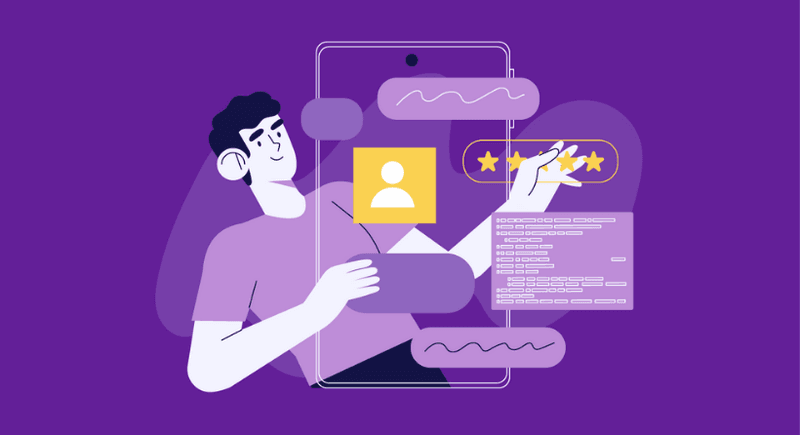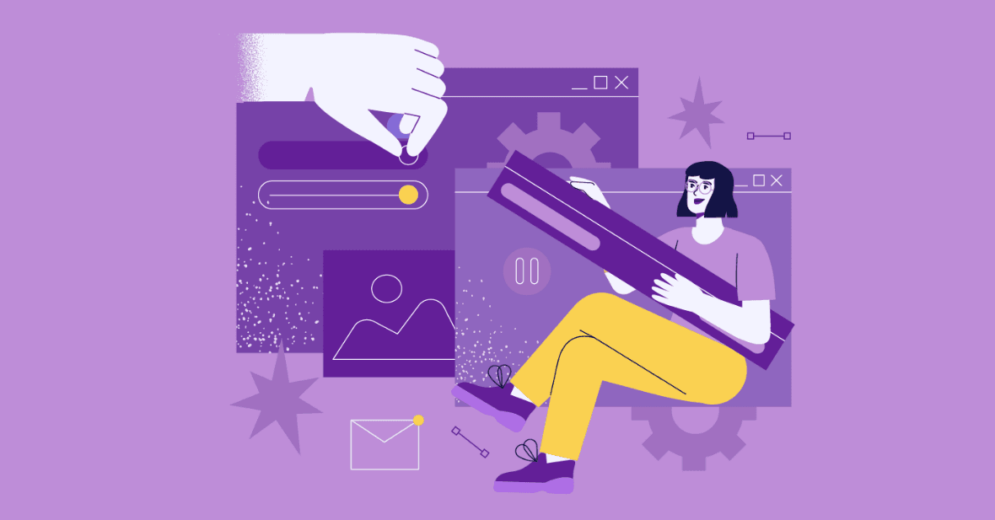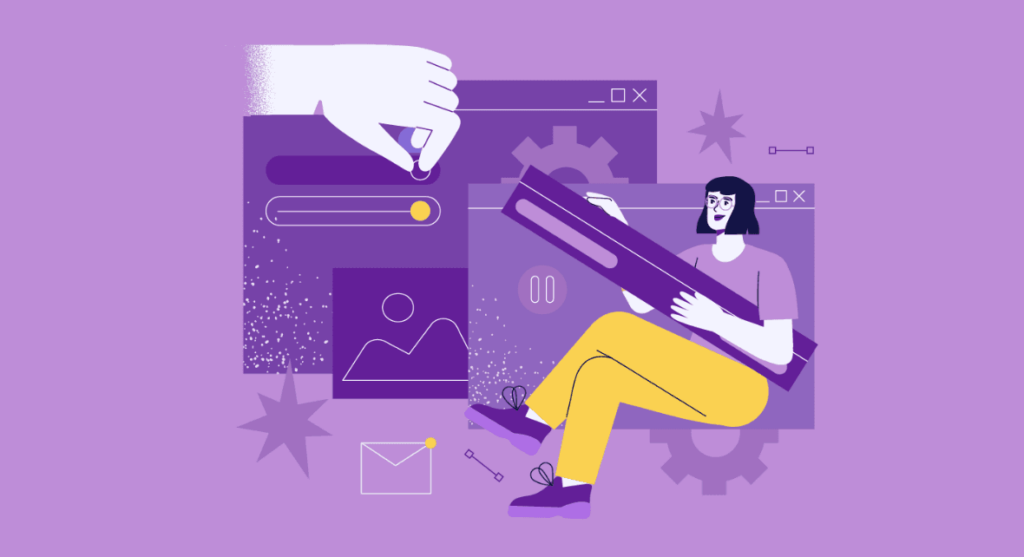Within UX Design it's possible to work in several areas: Research, UX Writing, UX/UI, Usability Analyst, etc.
Each of these areas requires certain specific competencies.
But there is a certain professional who encompasses a series of competencies and is able to talk and act in several areas of UX Design. This professional is the Product Designer.
Read on in this article and understand what are the responsibilities of the Product Designer and what are the 5 competencies needed to work in this profession!
What does a Product Designer do?
The Product Designer is the professional responsible for the design of digital products (software and applications, native or web), starting from the understanding and identification of a problem or real need until the development of solutions that include UX (User Experience) and UI (User Interface).
This way, they will always be involved in all phases of the project, working with teams from several areas, such as developers, computer engineers, marketing professionals, or any other business area.
It's also important to mention that the Product Designer – because they are designers working on products – will always be involved with some relevant methodology, such as Product Management, Agile, and Lean UX.
T-Shaped Professional
The Product Designer is part of a category of professionals who adhere to the T-Shaped concept.
Instead of focusing on just one step, or specializing entirely in one subject, the T-Shaped professional is one who knows all the processes end-to-end and knows how to act and work in several steps.
If we think of the old industrial model, Fordism, in which the employee who manufactured the wheels only knew how to do that process and nothing else, Product Design is just the opposite.
Because of this, there are fundamental competencies for those who want to work with Product Management and that are part of the T-Shaped Professional concept.
Reading Tip: Unintended Consequences: The Unforeseen Impacts of Technology
5 Essential Competencies of the Product Designer
As mentioned, a Product Designer goes from one end to the other in digital product projects.
In this regard, we can say that they are like soccer players who, despite having an official position, change shirts as they assume a new position and play well in all of them.
Thus, we list here the 5 main uniforms/essential competencies that the Product Designer must have to do well in the market:
- UX Research;
- Interaction Design;
- Usability;
- Visual Design;
- Prototyping.
1) UX Research

UX Research is the fundamental basis of the User-Centered Design process, which aims to identify and validate the real needs of users, answering questions such as:
- What problem are we solving?
- What is the best way to solve this problem?
- How can we know we have succeeded?
Thus, it is through this research stage that the Product Designer is able to:
- Profile users;
- Define the personas for your interface;
- Identify the user's needs and pains;
- Design the User Journey;
- Understand the relationship between user needs and business goals.
With this information, the Product Designer defines a project scope and explores solutions to meet user needs.
Typically, UX Research activities involve conducting quantitative research. These aim to measure numbers, such as questionnaires, metrics, and data analysis, among others. It also involves qualitative research activities, whose goal is to understand what is behind these numbers, such as interviews, field research, and user observation techniques, among countless others.
In addition, it is essential that the Product Designer understands the techniques of both types of research: Qualitative and Quantitative. In this way, they can prepare, apply, and analyze the results obtained through these studies.
A last important detail is that research activities are present during the whole cycle of product development, that is, the Product Designer must understand how to apply them in the different moments of the project.
Reading Tip: How To Develop A User-Friendly Website
2) Interaction Design

Within this competence, the Product Designer dives into the subtleties and details of how the user will interact with the interface, ensuring easy and intuitive interactions, with the lowest possible level of complexity.
Interaction Design comprises the user's actions on a system or application, aiming to align the mental models on an interface, as follows:
- Design model: the concept the designer has for the interaction;
- User model: the concept that the user has about the operation of the system;
- System image: the appearance of the system for its use, with manuals or instructions provided by the system.
Thus, the goal of Interaction Design is to bring the design model and the user model as close as possible, so that the system image is consistent. And then the user is able to interact with the machine.
Typical interaction design deliverables include specifications, wireframes, usage scenarios, prototypes, visual design, and animations.
In this sense, the Product Designer needs to be able to analyze the latest interaction trends and patterns. It's necessary to project a conceptual design that actually makes sense to that persona, outlined during the research phases.
Therefore, going through the development process, the Product Designer, when wearing the Interaction Designer shirt, needs to be, above all, attentive to human behavior patterns, allowing users to reach their goals through interaction with the interface.
3) Usability

Usability is the term that defines with what level of ease users can accomplish their objective, a final task, within the interface.
If inside a delivery application, the user can order their meal efficiently and quickly, this corresponds to the good usability of the platform.
So, when Product Designers focus on usability, their goal is to defend users against any difficulty they may have interacting with the product.
This practice is closely linked to Interaction Design because it is a key component that differentiates traditional visual design from user-centered design. Any device, physical or digital, if it is difficult or confusing to use, will generate dissatisfaction regardless of how beautiful or innovative it is.
Therefore, the Product Designer in this position should prioritize incorporating the user's mentality with empathy and validating functionality with usability tests to ensure everything is working well.
These tests will give the team the answers they need to follow or go back a few steps in the project.
Reading Tip: Building Prototypes: What’s The Best Type For Your UX/UI Project
4) Visual Design

Visual Design communicates much more than branding. For it is through the visual components of a screen that interactivity, information architecture, and task flows are exposed.
Thus, the challenge of the Product Designer in this competence is to transmit the real value that the project wants to deliver, through a good design. Remember that beautiful and well-designed interfaces are worth nothing if they don't deliver what the user is looking for when interacting with them.
In summary, there has to be a perfect match between what interaction design specifies and what visual design creates. And the person responsible for bridging this gap and ensuring that there is consistency in every element of the project is the Product Designer.
5) Prototyping

When Product Designers focus on prototyping, their goal is to alleviate uncertainties quickly, without much cost or effort.
A prototype, in UX, is a practical way to reproduce the product in order to test the hypotheses and solutions to the user.
In this sense, prototypes can be screens with clickable areas, animations, drawings, or even theatrical simulations. Everything will depend on the level of fidelity of the prototype, its objective, and the solution to be tested.
The basic principle is to produce something that looks real to a user in front of a test or research but is done with as little effort as possible.
In this way, when playing the prototyping game, the Product Designer sets the focus on exploring ideas in more interactive ways, in an attempt to get answers or communicate functionality to users (in testing) or developers.
Therefore, prototyping and usability testing form a perfect combo for refining the development of digital products.
Why are these competencies important?
The main role of a Product Designer is to follow the development of a product from end-to-end, knowing what happens in the beginning, middle, and end, and aligning the product to the business goals.
Therefore, these professionals need to understand every part of development. Yes, they may have more of a kinship with one competency or another, and this is the essence of a T-Shaped profile.
So, depending on the company and the project, Product Designers may focus more on one competence than on another. But despite this, they still need to be able to flow in the other competencies.
Therefore, if you want to work as a Product Designer or if you already work in the area and want to develop further in your career, it's interesting that you analyze in which of these competencies you need to improve, identifying your strengths and weaknesses.
Why does the market seek Product Designers?
We have seen a great search in the market today for Product Designers and multidisciplinary professionals in the T-Shaped model.
According to Felipe Melo, founder and Aela Mentor:
The market today is looking for a professional who does UX and UI, going from end to end in the process. And that, according to the needs of each company, can deepen in one area or another.
In some companies, these professionals are already being called Full Stack UX. That is, they do all the research, prototyping, motions, etc.
T-Shaped is an interesting approach for UX professionals and the market as a whole. It offers a diverse range of opportunities for professionals and allows companies to hire multi-skilled individuals, increasing the number of possibilities within a single role.
A bit about the current market for Product Designer
InVision is a company that offers one of the best-known prototyping tools in the world. It conducted a global survey last year. In it, it was evaluated what the market most demands from a Product Designer.
More than 1600 people were evaluated, including Product Designers and managers responsible for hiring these professionals. They answered several questions. Among them, what are the main competencies this type of Designer needs to stand out in the market.
According to this report:
98% of managers and hiring managers look for candidates with social skills. These include collaboration, teamwork, communication, and empathy.
In addition, other knowledge was also considered relevant: 74% of respondents consider management knowledge important.

The market for product designers is currently on the rise. Opportunities arise almost every day in large companies, in Brazil and also in other countries.
We hope this article will help you identify which essential competencies you need to develop to get an opportunity or stand out in the market as a Product Designer.








